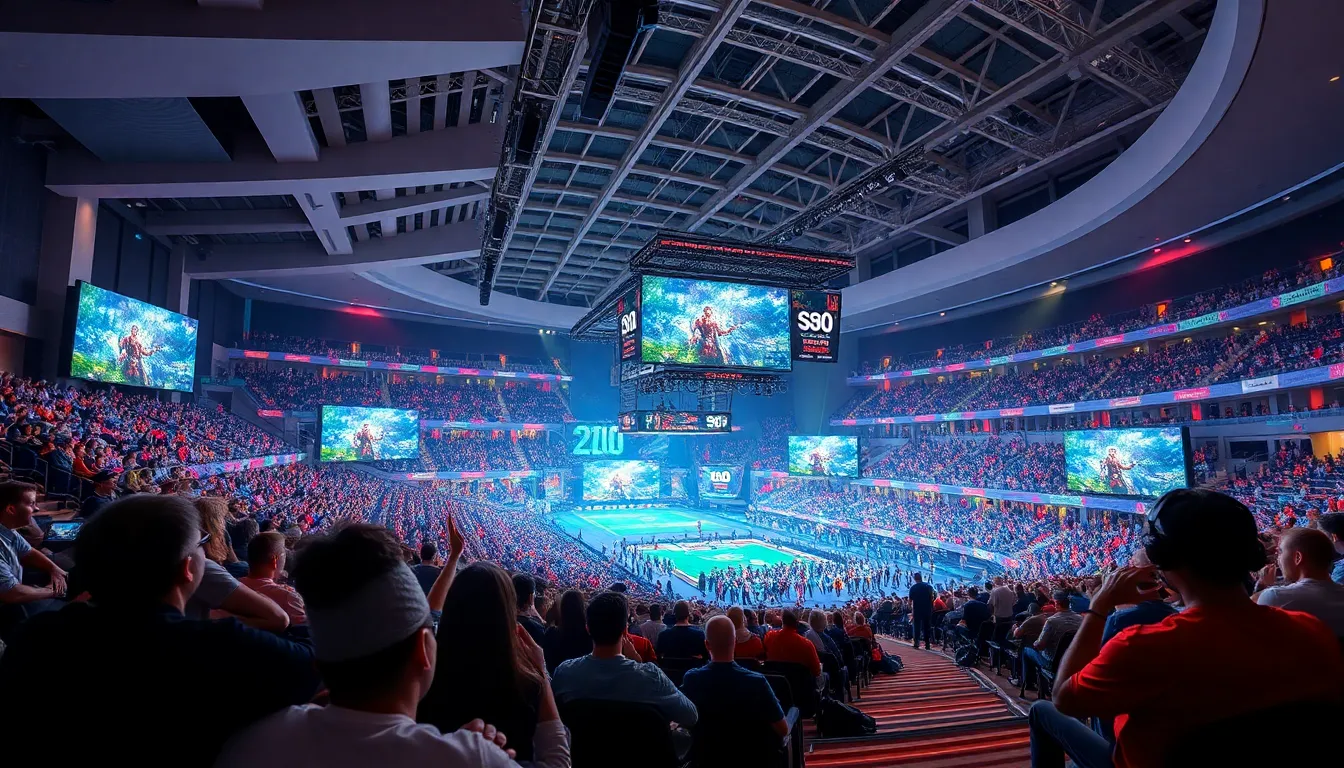In a world where gaming has evolved from basement battles to grand arenas, esports stadiums are the new coliseums. Picture this: thousands of fans, the roar of excitement, and players battling for glory on massive screens. It’s not just a game; it’s a spectacle that rivals any traditional sport.
Table of Contents
ToggleOverview Of Esports Stadiums
Esports stadiums represent a significant evolution in competitive gaming environments. These venues combine cutting-edge technology with immersive spectator experiences, providing fans with an engaging atmosphere. Designed specifically for esports, stadiums often feature high-definition screens, state-of-the-art audio systems, and advanced lighting setups, enhancing the overall presentation of events.
Key locations like the Esports Arena in Las Vegas and the Blizzard Arena in Burbank exemplify modern esports stadiums. Esports Arena hosts frequent tournaments and events, attracting thousands of fans for live competitions. Blizzard Arena, dedicated to Blizzard Entertainment’s games, offers a unique setting with a focus on community engagement.
Fan engagement remains a crucial aspect of esports stadiums. They often include interactive areas where spectators can participate in gaming experiences. Additionally, food and merchandise vendors enhance the atmosphere, allowing fans to indulge during events. These elements create a festival-like environment beyond the competition itself.
The financial impact of esports stadiums is substantial. Significant investments from sponsors and production companies underline the industry’s growth. For instance, substantial prize pools and marketing deals demonstrate the increasing popularity and profitability of esports. This financial backing supports infrastructure developments, making stadiums more accessible for future events.
Moreover, esports stadiums foster local economies by attracting tourists and boosting hospitality sectors. These facilities contribute to job creation across various sectors, including event management, security, and technical support. As esports continues its upward trajectory, the importance of these venues in shaping the competitive landscape becomes increasingly evident.
Features Of A Modern Esports Stadium

Modern esports stadiums incorporate advanced design elements that create a captivating atmosphere. Unique architecture often showcases large open spaces, ensuring optimal sightlines for spectators. Comfortable seating arrangements enhance viewer enjoyment, while themed areas immerse fans in the gaming experience. Flexible layouts accommodate various event formats, ranging from tournaments to fan meet-ups.
Technology integration plays a crucial role in enhancing the audience experience. High-definition LED screens display real-time game action and live statistics, ensuring fans don’t miss critical moments. Sophisticated audio systems immerse attendees in dynamic soundscapes, capturing the essence of gameplay. Furthermore, robust internet connectivity supports live streaming and interactive features, allowing remote viewers to engage alongside the audience. Investments in cutting-edge broadcasting equipment offer high production quality, heightening the overall event experience.
Popular Esports Stadiums Around The World
Esports stadiums attract massive crowds, showcasing competitive gaming at its finest. These venues offer state-of-the-art facilities and vibrant atmospheres for fans and players alike.
North America
North America hosts several premier esports stadiums, with notable venues enhancing the gaming experience. The Esports Arena in Las Vegas stands out with its modern design and interactive features, creating an immersive environment for attendees. Los Angeles features the Blizzard Arena, where fans enjoy thrilling competitions in a purpose-built space that showcases the best of esports. Toronto’s Coca-Cola Coliseum also plays host to major events, fostering a strong local esports community and drawing in tourists. Other cities, such as Seattle and Philadelphia, contribute to the growing footprint of esports, solidifying North America’s role in this global phenomenon.
Asia
In Asia, esports stadiums set the standard for high-energy events and cutting-edge technology. China’s Shanghai Oriental Sports Center serves as a major hub, hosting large-scale tournaments with thousands of attendees witnessing live action. South Korea’s OGN Super Arena captures the excitement of esports culture with its dynamic design and innovative presentation techniques. Japan’s Akihabara district features several esports venues, attracting gaming enthusiasts from across the country. Additionally, Singapore’s Suntec Convention Centre provides a flexible space for various esports events, showcasing the region’s commitment to building a vibrant esports ecosystem.
The Impact Of Esports Stadiums On The Community
Esports stadiums significantly influence their local communities. Increased tourism often results from hosting major events, bringing in fans eager to watch live competitions. Local restaurants and hotels benefit from this influx, as attendees seek accommodations and dining options.
Job creation plays a vital role in the economic impact of these venues. Construction jobs emerge during the building phase, while ongoing operations create positions in event management, security, and hospitality. Community members often find new employment opportunities in these growing sectors.
Youth engagement receives a boost with the establishment of esports stadiums. Many venues offer training programs and workshops aimed at aspiring gamers, fostering skill development and interest in the industry. Schools and organizations frequently partner with stadiums to provide students with unique experiences and exposure to esports culture.
Community events hosted at these arenas also strengthen local connections. Fan meet-and-greets, tournaments, and viewing parties create platforms for social interaction among gamers and enthusiasts. Engaging with the larger gaming community draws people together, reinforcing a sense of belonging.
Moreover, sponsorship and investment in esports stadiums contribute to long-term growth. Companies often channel resources into community initiatives, supporting local charities and events. This philanthropic focus promotes goodwill and enhances the reputation of both the sponsors and the stadiums.
Esports stadiums serve as economic engines and community hubs. They foster job creation, encourage youth engagement, and stimulate local economies. Through hosting events and supporting local initiatives, these venues elevate the community while paving the way for the future of esports.
Future Trends In Esports Stadium Development
Emerging technologies will greatly shape the development of esports stadiums. Innovations like augmented reality enhance spectator engagement by providing immersive experiences. Players can benefit from advancements in virtual reality training tools, improving their performance in competitive settings.
Sustainability initiatives are gaining traction, with many venues adopting eco-friendly materials and energy-efficient systems. Design elements will increasingly focus on multi-purpose functionality, catering to various events beyond esports. These adaptations will encourage broader community use, fostering local engagement.
Audience experience remains a priority, driving investments in high-speed internet access and interactive displays. Stadiums are likely to incorporate biometric technologies for seamless entry and personalized fan experiences. Attendees might enjoy features like mobile app integrations that provide instant access to game stats and player bios.
Collaboration between tech companies and venue owners is expected to accelerate. This partnership will facilitate the introduction of cutting-edge broadcasting techniques, ensuring smooth live-streaming experiences. Sponsorship opportunities will evolve, bringing new brands into the esports ecosystem.
Market research indicates an increase in venue capacity to accommodate larger audiences. Designers will craft stadiums that emphasize sightlines and acoustics, ensuring no one misses the action. As esports continue to grow, adaptive designs may expand to include outdoor venues, tapping into the popularity of festivals.
Long-term sustainability will hinge on ongoing investment from stakeholders, including gamers, sponsors, and local governments. The holistic approach will help establish esports stadiums as vital community hubs while reinforcing their economic impact. As a result, these future trends mark an exciting phase in the evolution of esports stadiums.
Esports stadiums are revolutionizing the way fans experience competitive gaming. These venues not only provide thrilling atmospheres for live events but also serve as essential community hubs that drive local economies. With advanced technology and immersive designs, they enhance spectator engagement and create unforgettable moments for audiences.
As the esports industry continues to grow, the significance of these stadiums will only increase. Their ability to attract tourism and foster community connections highlights their importance in the broader landscape of sports and entertainment. The future promises even more innovation, ensuring that esports stadiums remain at the forefront of this dynamic and exciting field.


